The events described here took place July 19th.
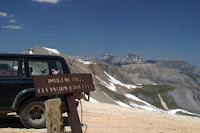 Imogene Pass is a very high (13,114 feet) pass between Ouray and Telluride. The first day we were in the area, 12 days ago, the road to the pass was closed by snow. By today, enough had melted that the road could be plowed. At right is the summit, looking north. The 360 degree view here was a spectacular tableau of rugged mountains, blue sky, and alpine vistas. According to one of our guide books, Imogene Pass is the second-highest pass (with a road) in the continental U.S. This is easy to believe when you're up on it, looking around at tall mountains that lay below you, and breathing the rareified air. We decided not to head down toward Telluride, as the vegetation on that side looked sparse and the tourists promised to be thick.
Imogene Pass is a very high (13,114 feet) pass between Ouray and Telluride. The first day we were in the area, 12 days ago, the road to the pass was closed by snow. By today, enough had melted that the road could be plowed. At right is the summit, looking north. The 360 degree view here was a spectacular tableau of rugged mountains, blue sky, and alpine vistas. According to one of our guide books, Imogene Pass is the second-highest pass (with a road) in the continental U.S. This is easy to believe when you're up on it, looking around at tall mountains that lay below you, and breathing the rareified air. We decided not to head down toward Telluride, as the vegetation on that side looked sparse and the tourists promised to be thick.
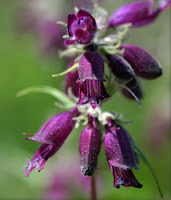
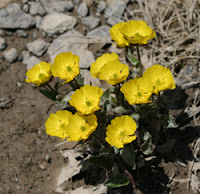 The trip from Lower Bird Camp to the pass itself was a new one for us, and it had one big surprise: the road follows a steep gulch with plenty of water flowing in it, making for many waterfalls and rapids. We had a good time knocking about in the area of the waterfalls. That water also meant the plant life was abundant and lush. The yellow flowers pictured at right were common in areas where snow had recently melted, right along side a white marigold. The violet flowers (which were more commonly a darker, almost black color) were very common all over the San Juan mountains, in a variety of conditions. We didn't know what either of these flowers were.
The trip from Lower Bird Camp to the pass itself was a new one for us, and it had one big surprise: the road follows a steep gulch with plenty of water flowing in it, making for many waterfalls and rapids. We had a good time knocking about in the area of the waterfalls. That water also meant the plant life was abundant and lush. The yellow flowers pictured at right were common in areas where snow had recently melted, right along side a white marigold. The violet flowers (which were more commonly a darker, almost black color) were very common all over the San Juan mountains, in a variety of conditions. We didn't know what either of these flowers were.
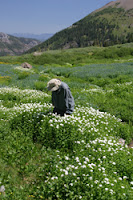
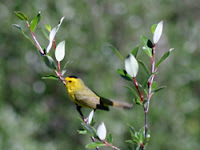 On one short walk, we hiked alongside a tumbling brook that was bordered by thickets of willow. In one of these thickets, the bird at right (an adult male Wilson's Warbler) was very curious about who I was and why I was in his territory. Naturally I did not have my telephoto with me on this walk, as I wasn't expecting to encounter any creatures of the birdly persuasion. But he was so close that even with my macro lens (which actually is a 100mm telephoto) I was able to get a photo good enough to identify him with. He stayed with me all the way to the edge of his thicket, but not a bit further. The scene at right is taken right nearby his thicket, where the brook emerges into a meadow that was just blanketed with wildflowers. The white flowers in the foreground are very fragrant, and only grow in very wet places (such as the banks of a brook). They were one of our favorites. The blue flowers in the background are cowslip, which was extremely common in this area.
On one short walk, we hiked alongside a tumbling brook that was bordered by thickets of willow. In one of these thickets, the bird at right (an adult male Wilson's Warbler) was very curious about who I was and why I was in his territory. Naturally I did not have my telephoto with me on this walk, as I wasn't expecting to encounter any creatures of the birdly persuasion. But he was so close that even with my macro lens (which actually is a 100mm telephoto) I was able to get a photo good enough to identify him with. He stayed with me all the way to the edge of his thicket, but not a bit further. The scene at right is taken right nearby his thicket, where the brook emerges into a meadow that was just blanketed with wildflowers. The white flowers in the foreground are very fragrant, and only grow in very wet places (such as the banks of a brook). They were one of our favorites. The blue flowers in the background are cowslip, which was extremely common in this area.
As usual, click on any picture for a larger view.

No comments:
Post a Comment